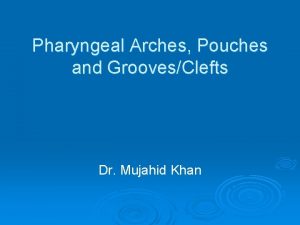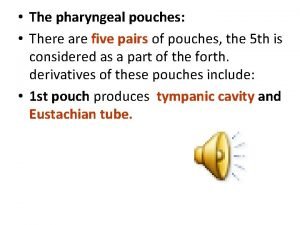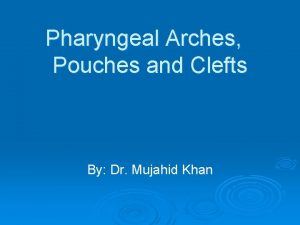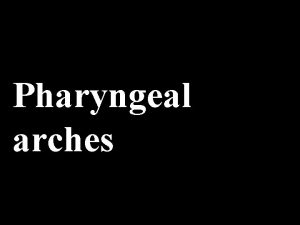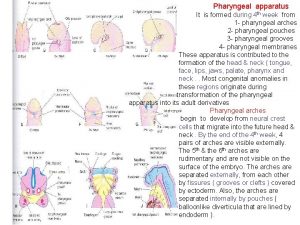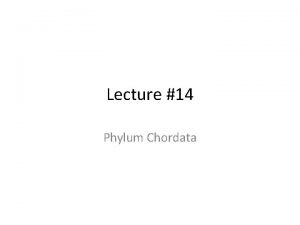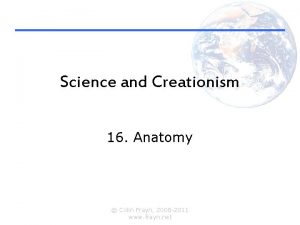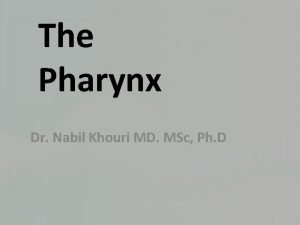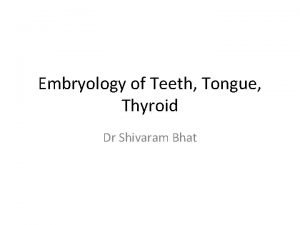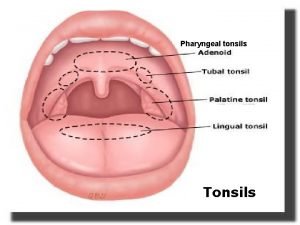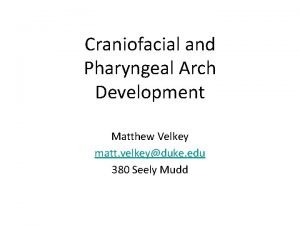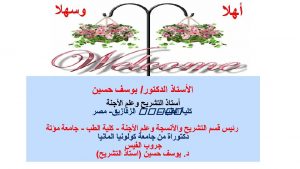The pharyngeal pouches There are five pairs of













- Slides: 13

• The pharyngeal pouches: • There are five pairs of pouches, the 5 th is considered as a part of the forth. derivatives of these pouches include: • 1 st pouch produces tympanic cavity and Eustachian tube.


• The 2 nd pouch produces palatine tonsils. • The 3 rd pouch produces the inferior parathyroid gland & thymus. • 4 th pouch produces superior parathyroid gland. • The 5 th pouch produces ultimobranchial body forms parafollicular C-cells of thyroid gland.


• The pharyngeal clefts: • These are 4 clefts that develop at 5 th wk, • 1 st cleft forms external auditary meatus & outer epithelium of eardrum. • The mesenchyme of the 2 nd pharyngeal arch grows & overlaps 3 rd & 4 th arches leading to closure of the 2 nd, 3 rd, and 4 th clefts from out side to form cervical sinus that disappears later on.


• Clinical notes: • 2 nd pharyngeal arch may fails to grow caudally and thus fails to cover the 2 nd, 3 rd, and 4 th clefts, a narrow canal called the branchial fistula connects them with surface just ant. to sternomastoid m. The cavity( lateral cervical cyst) lies below the angle of the mandible. This cyst is visible clearly during childhood.


• The tongue: • Bilateral lingual swellings and a median swelling (tuberculum impar) are formed from 1 st pharyngeal arch. • Also 2 nd, 3 rd, and 4 th arches form another median hypobranchial eminence called copula. • Finally, a third median swelling is formed by 4 th arch forming epiglottis anterior to orifice of larynx.


• Lateral lingual swellings overgrow tuberculum impar forming the ant. 2/3 or body of the tongue that is supplied by the mandibular branch of trigeminal N. which is N. of 1 st arch.

• posterior part (root) of tongue is separated by V-shaped sulcus terminalis from body & is derived from 2 nd, 3 rd, 4 th arches. • Root supplied by 9 th cranial nerve of 3 rd arch

• Extreme posterior part of tongue is supplied by the superior laryngeal branch of vagus of the 4 th arch. • Most of muscles of the tongue are from occipital somites and thus are supplied by the 12 th cranial nerve.
 Second pharyngeal groove modifies into auditory groove
Second pharyngeal groove modifies into auditory groove 3 4 pharyngeal pouch
3 4 pharyngeal pouch 3rd pharyngeal pouch
3rd pharyngeal pouch Pretrematic and post trematic nerves
Pretrematic and post trematic nerves Stomodeum
Stomodeum Antigentest åre
Antigentest åre Classification of phylum chordata
Classification of phylum chordata Gill pouches in humans
Gill pouches in humans Shapes of compounds
Shapes of compounds Pharyngeal veins
Pharyngeal veins Anodentia
Anodentia Palatine tonsils
Palatine tonsils Faríngea
Faríngea Structures derived from pharyngeal arches
Structures derived from pharyngeal arches
